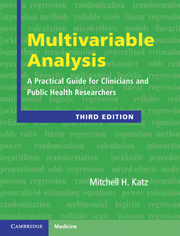Book contents
- Frontmatter
- Contents
- Preface
- 1 Introduction
- 2 Common uses of multivariable models
- 3 Outcome variables in multivariable analysis
- 4 Independent variables in multivariable analysis
- 5 Relationship of independent variables to one another
- 6 Setting up a multivariable analysis
- 7 Performing the analysis
- 8 Interpreting the results
- 9 Delving deeper: Checking the underlying assumptions of the analysis
- 10 Propensity scores
- 11 Correlated observations
- 12 Validation of models
- 13 Special topics
- 14 Publishing your study
- 15 Summary: Steps for constructing a multivariable model
- Index
- References
11 - Correlated observations
Published online by Cambridge University Press: 01 April 2011
- Frontmatter
- Contents
- Preface
- 1 Introduction
- 2 Common uses of multivariable models
- 3 Outcome variables in multivariable analysis
- 4 Independent variables in multivariable analysis
- 5 Relationship of independent variables to one another
- 6 Setting up a multivariable analysis
- 7 Performing the analysis
- 8 Interpreting the results
- 9 Delving deeper: Checking the underlying assumptions of the analysis
- 10 Propensity scores
- 11 Correlated observations
- 12 Validation of models
- 13 Special topics
- 14 Publishing your study
- 15 Summary: Steps for constructing a multivariable model
- Index
- References
Summary
What circumstances lead to correlated observations?
The multivariable methods that we have discussed thus far assume that each observation (subject) is independent (i.e., the outcomes of different subjects are not correlated). However, it has become increasingly common to study data where the observations are correlated with one another, often referred to as clustered observations or clusters.
As you can see from Table 11.1, a variety of circumstances leads to correlated observations. One common circumstance leading to correlated observations is longitudinal studies, where subjects are observed repeatedly (e.g., baseline and every six months thereafter). Because it is the same subject being observed multiple times, the responses are correlated (i.e., the same subject is more likely to have a similar response each time he or she is observed than a different subject would).
Repeated observations of subjects in longitudinal studies lead to correlated responses.
Also, when the same subject receives different treatments, as occurs in a crossover study, responses will be correlated because the same person is more likely to respond to different circumstances in a similar way than different individuals receiving different treatments. And the responses of different body parts of the same person (e.g., the right and left eye of Mr. A) will be correlated because the body parts of the same person are more likely to respond similarly than body parts belonging to different persons (e.g., the right eye of Mr. A and the left eye of Mr. B).
Information
- Type
- Chapter
- Information
- Multivariable AnalysisA Practical Guide for Clinicians and Public Health Researchers, pp. 185 - 207Publisher: Cambridge University PressPrint publication year: 2011
